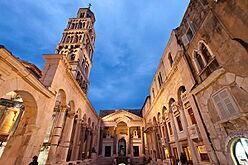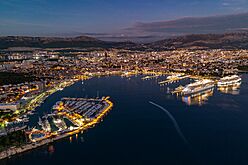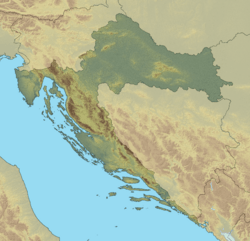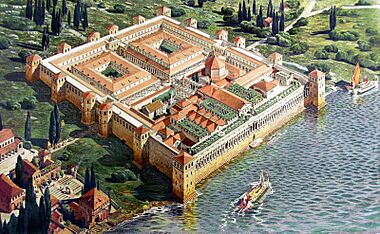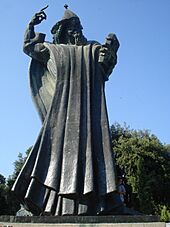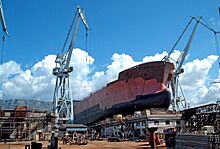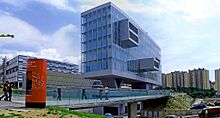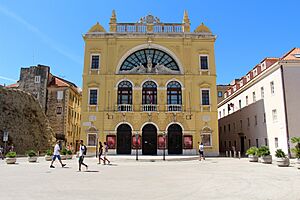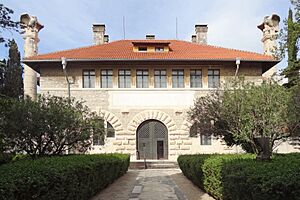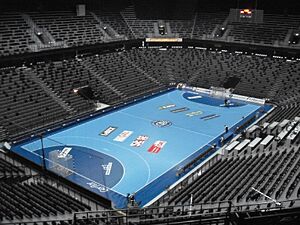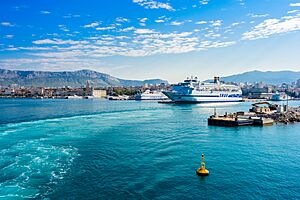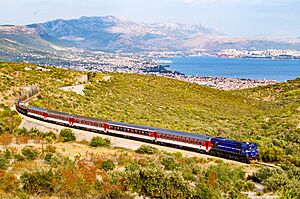Split, Croatia facts for kids
Quick facts for kids
Split
Spalato (Italian)
|
|||
|---|---|---|---|
| Grad Split City of Split |
|||
|
Diocletian's Palace
House of Vicko Nakić
Dalmatia Tower
Poljud Stadium
Prokurative
Bačvice Beach
Meštrović Gallery
View of city at night
|
|||
|
|||
| Nickname(s):
Velo misto ('[The] big town')
|
|||
| Anthem: Marjane, Marjane | |||
| Country | Croatia | ||
| County | Split-Dalmatia | ||
| Founded as Aspálathos | 3rd or 2nd century BCE | ||
| Diocletian's Palace built | 305 CE | ||
| Diocletian's Palace settled | 639 CE | ||
| Government | |||
| • Type | Mayor-Council | ||
| Area | |||
| • City | 79.4 km2 (30.7 sq mi) | ||
| • Urban | 23.1 km2 (8.9 sq mi) | ||
| Elevation | 0 m (0 ft) | ||
| Population
(2021)
|
|||
| • City | 160,577 | ||
| • Density | 2,022.4/km2 (5,238/sq mi) | ||
| • Urban | 149,830 | ||
| • Urban density | 6,486/km2 (16,800/sq mi) | ||
| Time zone | UTC+1 (CET) | ||
| • Summer (DST) | UTC+2 (CEST) | ||
| Postal code |
HR-21 000
|
||
| Area code | +385 21 | ||
| Vehicle registration | ST | ||
| Patron saint | Saint Domnius | ||
| UNESCO World Heritage Site | |||
| Official name | Historical Complex of Split with the Palace of Diocletian | ||
| Criteria | Cultural: (ii)(iii)(iv) | ||
| Inscription | 1979 (3rd Session) | ||
| Area | 20.8 ha (51 acres) | ||
Split is the second-largest city in Croatia, after the capital city Zagreb. It is the biggest city in the region of Dalmatia and the largest city along the Croatian coast. Split is located on the eastern shore of the Adriatic Sea. It spreads across a central peninsula and the areas around it.
Split is a busy transport hub and a popular place for tourists. It connects to many Adriatic islands and the Apennine Peninsula (Italy). More than 900,000 tourists visit Split every year.
The city started as a Greek colony called Aspálathos in the 3rd or 2nd century BCE. In 305 CE, the Roman emperor Diocletian built his famous Palace here. Split became an important city around 650 CE. This happened when people from the old Roman capital of Dalmatia, called Salona, moved to the fortified palace after their city was attacked.
Over time, Split was part of different empires and kingdoms. These included the Byzantine Empire, the Republic of Venice, and the Kingdom of Croatia. For many years, Split was a free city, caught between Venice and Croatia. Venice eventually took control. Split remained a Venetian city until 1797, when it became part of the Habsburg monarchy.
Later, it was briefly under French rule during the Napoleonic wars. After 1815, it became part of the Austrian Empire. After World War I, Split joined the Kingdom of Yugoslavia. During World War II, Italy annexed the city, but it was later liberated by Partisans. After the war, it became part of Socialist Yugoslavia. When Croatia became independent in 1991, Split faced some challenges but has since grown into a major tourist spot.
Contents
City Name: How Split Got Its Name
The name Aspálathos or Spálathos might come from a spiny plant called broom (Calicotome spinosa). This plant is common in the area.
After the Romans took over, the name became Spalatum or Aspalatum in Latin. In the Middle Ages, it changed to Aspalathum, Spalathum, Spalatrum, and Spalatro. This was in the Dalmatian language spoken by the local Romance-speaking people.
From the Early modern period, the official name in international papers was the Latin Spalatum. The Venetian spelling, Spalato, became official in the 18th century under Venetian rule. This is still the name of the city in Italian.
From the 10th century, locals used Spaleto. This led to the South Slavic forms: Splet, Spljet, and Split. In the 19th century, the Croatian names Split and Spljet became more popular. Finally, Split officially replaced Spljet in 1910.
People once thought the name came from the Latin word palatium, meaning 'palace'. This was because of Diocletian's Palace. However, the city is actually much older than the palace.
History of Split
Ancient Beginnings: Greek Colony to Roman Palace
Split's story often starts with Diocletian's Palace in 305 CE. But the city was actually founded much earlier. It began as a Greek colony called Aspálathos or Spálathos. This colony was set up by the city of Issa, which is modern-day Vis. Issa itself was a colony of Syracuse in Sicily.
We don't know the exact year Split was founded. It was likely in the 3rd or 2nd century BCE. The Greek settlers traded with the local Illyrian tribes, especially the Delmatae.
After the Illyrian Wars (229 and 219 BCE), the city of Salona became very important. Salona was close to Spálathos and became the capital of the Roman province of Dalmatia. It was one of the biggest cities of the late Roman Empire, with about 60,000 people. For a while, Spálathos was less known, being overshadowed by Salona.
In 293 CE, the Roman Emperor Diocletian (who ruled from 284 to 305 CE) began building a grand and strong palace. It was near his hometown of Salona, at the site of Spálathos (or Spalatum in Latin). The Palace was built like a huge Roman military fort. The palace and the city around it could hold 8,000 to 10,000 people.
Between 475 and 480 CE, the Palace was home to Flavius Julius Nepos. He was the last recognized Emperor of the Western Roman Empire. Salona was taken by the Ostrogothic Kingdom in 493 CE. But Emperor Justinian I got Dalmatia back in 535–536 CE.
Medieval Growth: From Palace to City
In 639 CE, the Pannonian Avars attacked and destroyed Salona. The Romans who survived fled to nearby islands. The Dalmatian region was then settled by Croats, a South Slavic people. Around 650 CE, the people from Salona returned. They settled in the 300-year-old Diocletian's Palace. The palace was strong enough to protect them from the Slavic tribes.
The Emperor Constans II allowed them to create the City of Spalatum within the Palace. This stopped fights with the Croatian Slavs. The Temple of Jupiter in the palace became a church for the Virgin Mary. The remains of Saint Domnius were brought from Salona. The Cathedral of Saint Domnius became the new main church.
Split remained part of the Byzantine Empire for a long time. During this period, a new language called Dalmatian language developed from Latin. The city became known as Spalatrum or Spalatro to its people.
In 925 CE, Tomislav's Kingdom of Croatia grew in the area behind Split. This kingdom was an ally of Byzantium. However, the city of Split remained under Byzantine control.
In 1100, the bell tower of the Cathedral was built. It became a main symbol of the city. It was dedicated to Saint Domnius, the city's patron saint.
Split was often attacked by the Narentines (a South Slavic group). So, the city asked Venice for help. In 998, the Venetian leader Pietro II Orseolo defeated the Narentines. He then called himself Duke of Dalmatia.
Later, Split came under the rule of the Kingdom of Croatia and then the Kingdom of Hungary. The city was given special rights, like choosing its own leaders and not paying tribute. These rights helped Split stay somewhat independent.
In 1409, a Hungarian king sold his rights to Dalmatia to the Venetian Republic. By 1420, Venice took full control of Split.
Venetian Rule and Later Changes
During the Venetian period, most people in Split were Croats. The main language was Croatian. However, a form of Venetian language was also spoken by important people like notaries and merchants. Venice reduced the city's self-rule. The highest leader was a Venetian official.
Split became an important port city. It had strong trade routes to the Ottoman lands through the nearby Klis pass. Culture also thrived. Split was the home of Marko Marulić, a famous Croatian poet. His most famous work, Judita, was an epic poem. It is considered the first modern work of Croatian literature.
However, these cultural achievements were mostly for the rich. Many people could not read or write. Venetian rule did not focus much on education or health.
In 1797, Split was given to the Habsburg monarchy (Austrian Empire). This happened when the Republic of Venice fell apart.
Modern Times: Wars and Growth
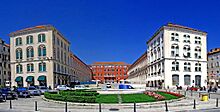
Split became part of the Napoleonic Kingdom of Italy in 1805. Then, in 1806, it was directly included in the French Empire. During this time, a lot of money was invested in the city. New streets were built, and old walls were removed.
In 1809, Split became part of the Illyrian Provinces, which were controlled by France. After the French rule ended, Split was officially given to Austria in 1815.
Under Austrian rule, Split was part of the Kingdom of Dalmatia. In the 19th century, two main political groups appeared. One group wanted Dalmatia to join the Kingdom of Croatia-Slavonia. The other group wanted more self-rule or to join Italy.
Antonio Bajamonti was the Mayor of Split for over 20 years, from 1860 to 1880.
Joining Yugoslavia
After World War I, the Austro-Hungarian Empire broke apart. Split became part of the Kingdom of Serbs, Croats and Slovenes. This country later became the Kingdom of Yugoslavia in 1929. Split became a very important port. The Lika railway, which connected Split to the rest of the country, was finished in 1925.
World War II and After
In April 1941, during World War II, Italy occupied Split. Italy officially took over Split in May 1941. This made Split a center of resistance against the Italian rule. Many people joined the Partisans. Local football clubs like HNK Hajduk and RNK Split stopped playing and joined the Partisans.
In September 1943, Italy surrendered. Partisan forces briefly took control of Split. Thousands of people joined them. However, the German army soon re-occupied the city. They gave it to the Independent State of Croatia, which was allied with Germany.
During the war, Split was bombed by both Axis and Allied forces. This caused many deaths. The Partisans finally captured the city on October 26, 1944. Split became the temporary capital of Croatia. After the war, Split became part of Socialist Yugoslavia.
Growth in Socialist Yugoslavia
After World War II, Split grew very fast. Many new factories and companies were started. The city's population tripled. Split became a major economic center. Industries like shipbuilding, food, chemicals, and textiles grew.
The shipbuilding industry was very successful. Yugoslavia, with its shipyards in Croatia, became one of the world's top shipbuilding nations. Many sports facilities were also built, especially for the 1979 Mediterranean Games. These included the Poljud Stadium. Split also became the biggest passenger and military port in Yugoslavia.
Split Since Independence
In 1991, Croatia declared its independence from Yugoslavia. This led to a difficult time for Split. There was a stand-off between the Yugoslav army and Croatian forces. On November 15, 1991, a Yugoslav warship fired some shells at the city. The damage was small, but some people were hurt. The Yugoslav army left Split in January 1992.
After the war, Split faced an economic downturn. However, after 2000, the city started to grow again. It focused on tourism. Split is now a major tourist destination in Croatia. Many new hotels, apartments, and office buildings are being built. Large projects like the Spaladium Arena, built in 2009, show this new growth.
Geography of Split
Split is located on a peninsula. This land is between the eastern part of the Gulf of Kaštela and the Split Channel. The Marjan hill (178 meters high) rises on the western side of the peninsula. The Kozjak (779 meters) and Mosor (1339 meters) mountains protect the city from the north and northeast. They also separate Split from the inland area.
Split is divided into 34 city areas called kotars:
- Bačvice
- Blatine-Škrape
- Bol
- Brda
- Grad
- Gripe
- Kman
- Kocunar
- Lokve
- Lovret
- Lučac-Manuš
- Mejaši
- Meje
- Mertojak
- Neslanovac
- Plokite
- Pujanke
- Ravne njive
- Sirobuja
- Skalice
- Split 3 (Smrdečac and Pisano Kame)
- Sućidar
- Šine
- Spinut
- Trstenik
- Veli Varoš
- Visoka
- Žnjan
Climate in Split
Split has a Hot-summer Mediterranean climate. This means it has hot, mostly dry summers. Winters are mild and wet. Sometimes, a strong northern wind called bura can make it feel cold.
January is the coldest month, with average low temperatures around 6°C. July is the hottest month, with average high temperatures around 31°C. The city gets about 800 mm of rain each year. November is the wettest month, with nearly 120 mm of rain and about 12 rainy days. July is the driest month, with only about 25 mm of rain.
Snow is rare in Split. However, in February 2012, there was a record snowfall of 25 cm. This caused big traffic problems. Split enjoys more than 2,600 hours of sunshine every year.
In July 2017, firefighters fought a large forest fire near Split. It damaged buildings in villages around the city.
| Climate data for Split (Marjan Hill, 1991–2020, extremes 1948–2019) | |||||||||||||
|---|---|---|---|---|---|---|---|---|---|---|---|---|---|
| Month | Jan | Feb | Mar | Apr | May | Jun | Jul | Aug | Sep | Oct | Nov | Dec | Year |
| Record high °C (°F) | 17.4 (63.3) |
22.3 (72.1) |
24.3 (75.7) |
27.7 (81.9) |
33.2 (91.8) |
38.1 (100.6) |
38.6 (101.5) |
38.5 (101.3) |
34.2 (93.6) |
27.9 (82.2) |
25.8 (78.4) |
18.6 (65.5) |
38.6 (101.5) |
| Mean daily maximum °C (°F) | 10.7 (51.3) |
11.5 (52.7) |
14.5 (58.1) |
18.4 (65.1) |
23.4 (74.1) |
28.1 (82.6) |
31.0 (87.8) |
30.9 (87.6) |
25.4 (77.7) |
20.5 (68.9) |
15.6 (60.1) |
11.8 (53.2) |
20.2 (68.3) |
| Daily mean °C (°F) | 8.2 (46.8) |
8.7 (47.7) |
11.3 (52.3) |
14.9 (58.8) |
19.7 (67.5) |
24.2 (75.6) |
26.8 (80.2) |
26.8 (80.2) |
21.7 (71.1) |
17.4 (63.3) |
13.1 (55.6) |
9.4 (48.9) |
16.8 (62.3) |
| Mean daily minimum °C (°F) | 5.9 (42.6) |
6.0 (42.8) |
8.5 (47.3) |
11.8 (53.2) |
16.1 (61.0) |
20.2 (68.4) |
22.8 (73.0) |
22.9 (73.2) |
18.4 (65.1) |
14.7 (58.5) |
10.8 (51.4) |
7.2 (45.0) |
13.8 (56.8) |
| Record low °C (°F) | −9.0 (15.8) |
−8.1 (17.4) |
−6.6 (20.1) |
0.3 (32.5) |
4.8 (40.6) |
9.1 (48.4) |
13.0 (55.4) |
11.2 (52.2) |
8.8 (47.8) |
3.8 (38.8) |
−4.5 (23.9) |
−6.3 (20.7) |
−9.0 (15.8) |
| Average precipitation mm (inches) | 72.7 (2.86) |
63.8 (2.51) |
58.4 (2.30) |
62.0 (2.44) |
57.8 (2.28) |
49.2 (1.94) |
24.6 (0.97) |
31.7 (1.25) |
82.3 (3.24) |
79.6 (3.13) |
119.8 (4.72) |
98.7 (3.89) |
800.6 (31.53) |
| Average precipitation days (≥ 0.1 mm) | 10.5 | 9.4 | 9.6 | 10.4 | 9.4 | 7.8 | 5.1 | 4.6 | 8.2 | 9.3 | 11.7 | 11.9 | 107.9 |
| Average snowy days | 0.3 | 0.6 | 0.3 | 0 | 0 | 0 | 0 | 0 | 0 | 0 | 0.1 | 0.2 | 1.5 |
| Average relative humidity (%) | 61 | 59 | 59 | 59 | 56 | 53 | 49 | 51 | 58 | 63 | 65 | 61 | 58 |
| Mean monthly sunshine hours | 139.5 | 151.7 | 195.1 | 221.5 | 277.9 | 317.8 | 358.7 | 335.0 | 246.3 | 197.8 | 129.3 | 127.9 | 2,698.5 |
| Percent possible sunshine | 47 | 55 | 54 | 56 | 65 | 72 | 81 | 79 | 70 | 61 | 50 | 48 | 63 |
| Source 1: NOAA NCEI | |||||||||||||
| Source 2: Croatian Meteorological and Hydrological Service(percent sun-extremes) | |||||||||||||
| Climate data for Split | |||||||||||||
|---|---|---|---|---|---|---|---|---|---|---|---|---|---|
| Month | Jan | Feb | Mar | Apr | May | Jun | Jul | Aug | Sep | Oct | Nov | Dec | Year |
| Mean No. of days with Maximum temperature ≥ 30.0 °C (86.0 °F) | 0 | 0 | 0 | 0 | 0.7 | 9.7 | 20.8 | 20.5 | 2.5 | 0 | 0 | 0 | 54.2 |
| Mean No. of days with Minimum temperature < 0.0 °C (32.0 °F) | 1.4 | 2.0 | 0.4 | 0 | 0 | 0 | 0 | 0 | 0 | 0 | 0 | 0.9 | 4.8 |
| Mean No. of days with Precipitation ≥ 10.0 mm (0.39 in) | 2.7 | 2.3 | 1.9 | 2.1 | 2.0 | 1.5 | 0.6 | 1.0 | 2.7 | 2.4 | 4.0 | 3.3 | 26.7 |
| Mean No. of days with Snow Depth ≥ 1.0 cm (0.39 in) | 0 | 0.7 | 0 | 0 | 0 | 0 | 0 | 0 | 0 | 0 | 0 | 0 | 0.7 |
| Mean number of days with thunder | 2.2 | 1.8 | 1.7 | 2.5 | 3.7 | 4.6 | 3.8 | 4.1 | 4.7 | 3.1 | 4.2 | 2.7 | 39 |
| Mean number of days with hail | 0.3 | 0.3 | 0.3 | 0.1 | 0.1 | 0.2 | 0.1 | 0.0 | 0.1 | 0.2 | 0.2 | 0.2 | 2.2 |
| Mean number of days with fog/Ice fog | 0.1 | 0.3 | 0.4 | 0.3 | 0.1 | 0.0 | 0.1 | 0.1 | 0.0 | 0.1 | 0.1 | 0.0 | 1.7 |
| Jan | Feb | Mar | Apr | May | Jun | Jul | Aug | Sep | Oct | Nov | Dec | Year |
|---|---|---|---|---|---|---|---|---|---|---|---|---|
| 12.0 °C (53.6 °F) | 11.5 °C (52.7 °F) | 11.9 °C (53.4 °F) | 13.8 °C (56.8 °F) | 17.3 °C (63.1 °F) | 21.1 °C (70.0 °F) | 23.2 °C (73.8 °F) | 23.6 °C (74.5 °F) | 21.7 °C (71.1 °F) | 19.3 °C (66.7 °F) | 16.4 °C (61.5 °F) | 13.7 °C (56.7 °F) | 17.1 °C (62.8 °F) |
People of Split
Population Numbers
| Historical population | ||
|---|---|---|
| Year | Pop. | ±% |
| 1857 | 12,417 | — |
| 1869 | 14,587 | +17.5% |
| 1880 | 16,883 | +15.7% |
| 1890 | 18,483 | +9.5% |
| 1900 | 21,925 | +18.6% |
| 1910 | 25,103 | +14.5% |
| 1921 | 29,155 | +16.1% |
| 1931 | 40,029 | +37.3% |
| 1948 | 54,187 | +35.4% |
| 1953 | 64,874 | +19.7% |
| 1961 | 85,374 | +31.6% |
| 1971 | 129,203 | +51.3% |
| 1981 | 176,303 | +36.5% |
| 1991 | 200,459 | +13.7% |
| 2001 | 188,694 | −5.9% |
| 2011 | 178,102 | −5.6% |
| 2021 | 160,577 | −9.8% |
In 2021, the city of Split had 160,577 people living there. Most of the people (96.42%) are Croats. Also, 77.53% of the people in Split are Roman Catholics.
The administrative area of Split includes these smaller towns and settlements (from 2011):
- Donje Sitno, population 313
- Gornje Sitno, population 392
- Kamen, population 1,769
- Slatine, population 1,106
- Split, population 167,121
- Srinjine, population 1,201
- Stobreč, population 4,978
- Žrnovnica, population 3,222
The larger urban area of Split has about 293,298 people. The even wider metropolitan area has 346,314 people. The entire Split-Dalmatia County has 454,798 residents.
| population |
12417
|
14587
|
16883
|
18438
|
21925
|
25103
|
29155
|
40029
|
54187
|
64874
|
85374
|
129203
|
176303
|
200459
|
188694
|
178102
|
160577
|
| 1857 | 1869 | 1880 | 1890 | 1900 | 1910 | 1921 | 1931 | 1948 | 1953 | 1961 | 1971 | 1981 | 1991 | 2001 | 2011 | 2021 |
Local Groups in Split
People from Split are called Splićani. They traditionally belong to three main groups. The oldest families are called the Fetivi. They are very proud of their city and its unique way of speaking.
Another group is the Boduli. These are people who moved from the nearby Adriatic islands. They mostly arrived in the 20th century.
The third and largest group are the Vlaji. These are immigrants from the rural area behind Split called Zagora. They moved to Split in large numbers after World War II. They often worked hard in the city's new industries.
Economy of Split
Split's economy has changed a lot. In the past, during the Yugoslav era, Split was a very important economic center. It had many different industries. These included shipbuilding, food processing, chemicals, plastics, textiles, and paper industry. Tourism also brought in a lot of money.
In 1981, Split's economic output per person was 37% higher than the average for Yugoslavia. Today, many factories are closed or produce much less. The city is now focusing more on trade and tourism. This has led to many factory workers losing their jobs.
Brodosplit is the biggest shipyard in Croatia. It employs about 2,300 people. It has built over 350 ships, including tankers, container ships, and passenger ships. Most of the ships built (80%) are sold to other countries.
The new A1 motorway, which connects Split to the rest of Croatia's highway system, has helped the economy. New businesses are being built in the city center and its growing suburbs. The entire highway opened in July 2005.
Today, Split's economy mainly depends on trade and tourism. Some older industries are slowly coming back. These include food production (like fishing, olive, and wine production), paper, concrete, and chemicals. Since 1998, Split has hosted the yearly Croatia Boat Show.
Education in Split
Split has 24 primary schools and 23 secondary schools. This includes 11 grammar schools.
University of Split
The University of Split (Croatian: Sveučilište u Splitu) was founded in 1974. It has grown a lot in recent years. Now, it has 18,000 students. It is organized into 12 faculties (departments) and 1 Academy (Arts Academy).
Split has the biggest university campus in Croatia. It has all the necessary facilities. This includes all the faculties, a large student center with a sports hall, sports fields, and a university library.
Culture in Split
In 1979, the historic center of Split became a UNESCO World Heritage Site. Split is known as one of the centers of Croatian culture. Its writing tradition goes back to medieval times. Famous writers include Marko Marulić. More recently, authors like Miljenko Smoje and Ivo Tijardović have been important.
Museums and Art Galleries
The Split Archaeological Museum (Croatian: Arheološki muzej) is the oldest museum in Croatia. It was founded in 1820. It has about 150,000 items. These items cover prehistoric times, Greek and Roman periods, and the early Middle Ages. You can see stone writings from Salona, Greek pottery, Roman glass, and old coins.
The Museum of Croatian Archaeological Monuments (Croatian: Muzej hrvatskih arheoloških spomenika) is special. It is the only museum in Croatia that focuses on Croatian cultural items from the Middle Ages. This includes items from the early medieval Croatian state (9th to 12th century).
The Split City Museum (Croatian: Muzej Grada Splita) is in the old Papalić Palace. It shows the city's urban, cultural, artistic, and economic history. It also has the Emanuel Vidović Gallery, dedicated to a famous Split painter.
The Ethnographical Museum (Croatian: Etnografski muzej) has many items from Dalmatia. It collects traditional heritage and shows how it is used today.
The Croatian Maritime Museum (Croatian: Hrvatski pomorski muzej) has a collection of marine equipment, weapons, and ship models. It tells the story of military and naval history from when the Slavs arrived until today.
The Split Science Museum and Zoo (Croatian: Prirodoslovni muzej i zoološki vrt) is on the Marjan peninsula.
The Gallery of Fine Arts (Croatian: Galerija umjetnina) has art from the 14th century to today. It shows how art developed in the area. It has works by famous Croatian artists like Ivan Meštrović. The gallery also has many icons.
The Ivan Meštrović Gallery (Croatian: Galerija Meštrović) is on the Marjan peninsula. It is dedicated to the works of the 20th-century sculptor, Ivan Meštrović. The building itself was designed by Meštrović.
Music Scene
Split is famous for its popular music. Many influential musicians come from here. These include composers like Franz von Suppé and Jakov Gotovac.
Famous musicians and bands from Split include Oliver Dragojević, Gibonni, Severina, and Dino Dvornik.
During the summer, the Split Music Festival is held. There is also the Split Summer (Splitsko ljeto) theater festival. Since 2013, the Ultra Europe electronic music festival takes place at the Poljud stadium in July.
Split also has a strong hip hop scene. Groups like The Beat Fleet and Dječaci are well-known.
Sports in Split
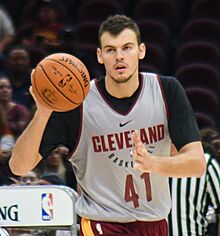
Split is known for producing many sports champions. People in Split often call their city "the sportiest city in the world." Popular sports include association football, tennis, basketball, swimming, rowing, sailing, waterpolo, athletics, and handball.
The main football club is HNK Hajduk Split. It is one of the most popular clubs in Croatia. Its fans are called Torcida Split, the oldest fan group in Europe (started in 1950). The largest football stadium is the Poljud Stadium. Famous players like Slaven Bilić and Igor Tudor started their careers at Hajduk.
Basketball is also very popular. The city's basketball club, KK Split, won the EuroLeague three times in a row (1989–1991). Famous players like Toni Kukoč and Dino Rađa are from Split.
Famous tennis players from Split include Goran Ivanišević (who won Wimbledon in 2001) and Mario Ančić.
The local rowing club HVK Gusar has won many medals at the Olympics and World Rowing Championships.
Swimming has a long history in Split. Đurđica Bjedov won an Olympic gold medal in 1968. Duje Draganja is another top swimmer from the city. The champion high jumper Blanka Vlašić is also from Split.
Split hosted the 1979 Mediterranean Games and the 1990 European Athletics Championships. In 2009, Split was one of the host cities for the 2009 World Men's Handball Championship. A new arena, the Spaladium Arena, was built for this event. It can hold about 12,000 spectators.
Split used to have three top water polo clubs that won many titles. Many water polo players from Split have won medals at the Olympics and World Championships. Some have been considered the best in the world, like Ratko Rudić and Milivoj Bebić.
Picigin is a traditional local sport. It started in 1908 and is played on the sandy Bačvice beach. Five players play in very shallow water with a small, peeled tennis ball. It's a tradition to play picigin in Split on New Year's Day, even if the sea is cold.
RK Nada was a pioneer in rugby union in the region. They were the strongest club in former Yugoslavia and are very successful in Croatia today.
Baseball has a long tradition in Split, starting in 1918. The local team, Nada, plays its home games at the old Hajduk stadium. The Croatian national baseball team, with many players from Split, is ranked 25th in the world.
The Split SeaWolves club is the only American football team in Dalmatia. They started in 2008 and are growing, focusing on flag football.
Transportation in Split
Split is an important transport center for Dalmatia and the wider area. The Zagreb-Split freeway (A1) connects Split to the rest of Croatia's highway network. The Adriatic Highway also passes through the city, connecting Rijeka to Dubrovnik along the coast.
The local public transport company, Promet Split, runs bus lines within the city and to nearby areas. Split does not have a tram system because of its hilly landscape.
The Split Airport is in Kaštela, about 20 km from Split. It is the second largest airport in Croatia by passenger numbers. It has flights to Croatian cities and some European destinations all year. Many more flights are added during the summer.
The Port of Split is the third busiest port in the Mediterranean. It serves 4 million passengers every year. It connects Split to nearby islands like Brač, Hvar, and Šolta. It also has routes to Rijeka, Dubrovnik, and Ancona in Italy. Split is also becoming a major cruise ship destination. Over 260 cruise ships visit each year, bringing 130,000 passengers.
Split has a railway station in the city center, near the main port. It is the end point for Croatian Railways' long-distance trains to Zagreb. It also has commuter trains that run between Split and Kaštel Stari. During summer, there are overnight trains to Osijek/Vukovar, Budapest, and Vienna/Bratislava. There is another train station called "Split Predgrađe" (Split Suburbia) in the northern part of the city.
Gallery
International Connections
Twin Towns and Sister Cities
Split is twinned with these cities:
 Ancona, Italy
Ancona, Italy Antofagasta, Chile
Antofagasta, Chile Beit Shemesh, Israel
Beit Shemesh, Israel Charlottenburg-Wilmersdorf (Berlin), Germany
Charlottenburg-Wilmersdorf (Berlin), Germany Cockburn, Australia
Cockburn, Australia Dover, United Kingdom
Dover, United Kingdom Gladsaxe, Denmark
Gladsaxe, Denmark Kraków, Poland
Kraków, Poland Los Angeles, United States
Los Angeles, United States Mostar, Bosnia and Herzegovina
Mostar, Bosnia and Herzegovina Odesa, Ukraine
Odesa, Ukraine Ostrava, Czech Republic
Ostrava, Czech Republic Rzeszów, Poland
Rzeszów, Poland Sarandë, Albania
Sarandë, Albania Štip, North Macedonia
Štip, North Macedonia Trondheim, Norway, since 1956
Trondheim, Norway, since 1956 Velenje, Slovenia
Velenje, Slovenia
Partnerships
Split is partnered with:
 Beirut, Lebanon
Beirut, Lebanon Bandar Lampung, Indonesia
Bandar Lampung, Indonesia Cagli, Italy
Cagli, Italy Cetinje, Montenegro
Cetinje, Montenegro Iquique, Chile
Iquique, Chile İzmir, Turkey
İzmir, Turkey Kermanshah, Iran
Kermanshah, Iran Patras, Greece
Patras, Greece Pescara, Italy
Pescara, Italy Punta Arenas, Chile
Punta Arenas, Chile Rosario, Argentina
Rosario, Argentina
Famous People from Split
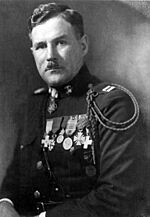
- Ivo Politeo (1887-1956), a lawyer
- Louis Cukela (1888-1956), a US Marine Major born in Split
See also
 In Spanish: Split para niños
In Spanish: Split para niños


